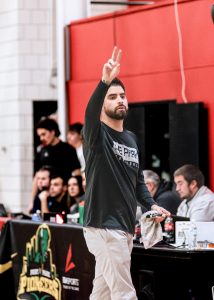Robot umpires are the answer, but only for balls and strikes
November 20, 2019
For as long as baseball has existed there have been human umpires. Human umpires make mistakes just like any other person, but in the World Series you just can’t afford the biggest games of the year being influenced by an umpire’s mistake.
According to a massive study after the 2018 MLB season, MLB umpires made 34,294 incorrect calls when calling balls and strikes. That’s 14 bad calls on pitches per game. Sure it’s one pitch, but it’s a ball four in game five of the World Series for one player in the lineup and the next player receives what looked like that same pitch but gets rung up. That can’t fly.
In 2019 the Atlantic League experimented with a computer umpire in their All-Star Game. The computer system used doppler radar to call the pitches. The computer system was placed on top of the grandstand behind the plate and after the pitch it would transfer those call to the home plate umpires earpiece connected via Bluetooth to his iPhone in his pocket. The umpire still had to get into his regular crouch behind the catcher to be prepared to override the computer because the doppler radar had some malfunctions where it called balls strikes when they were a foot outside, and the balls that bounced before the plate into the strike zone were called strikes as well.
MLB Commissioner Rob Manfred says there is no timetable for this new technology coming to the majors, as he wants to see how the experiment works in other minor leagues besides the Atlantic League. As of right now the strike zones are determined by the average baseball player’s height. I would figure you want to learn how to configure all MLB player’s heights into the computer before you bring the tech into consideration. And in doing so you need to know that you can rely on that for instance when a team calls up a kid from the minor leagues and he hasn’t had a MLB at bat yet.
It’s a great idea to have a robot umpire to assist and empower an umpire behind the plate, but I don’t think a robot umpire is needed for the field positions. Percentages drastically go down for the umpires’ missed call percentage in the field positions. There were some bad ones in the past, and the one that comes to my mind right away is when Armando Gallaraga, a pitcher for the Detroit Tigers at the time, had a perfect game in the 9th inning with two outs and the umpire, Jim Joyce, missed the call at first base. In today’s game umpires can look at replay, and that play would’ve been overturned.
The play many people in the world went into a frenzy about was in game 6 of the World Series Washington Nationals when shortstop Trea Turner hit a perfectly placed chopper down the third baseline. Houston Astros pitcher Brad Peacock picked up the ball and threw it in the vicinity of first base. Turner made contact with the Astros first baseman Yuri Gurriel hindering him from reaching to catch the ball, Turner knocked Gurriel’s glove off and the ball went into right field. If nothing happened the Nationals would have had one out and a runner on second and third, but that didn’t happen.
Umpire Sam Holbrook made the call of baserunner obstruction. When the normal ear hears “baserunner obstruction” they think there was a collision, which there was, so they blamed it on the bad throw and everyone said it was a terrible call by Holbrook. Whereas actually Holbrook made the right call. When Turner was running to first base he was running on the inside of the foul line the whole time. On a baseball field on the first base foul line half way down to first base there is a second line three feet to the right of the actual foul line and this is called the 45 foot line. The runner must be inside the two lines in that designated area while running to get to first base. Turner did not do that therefore he was correctly called out. In my opinion the rule is terrible and either needs to be changed OR they should add what they call in youth recreation ball a “safety bag”.
This call by Holbrook gives me the reassurance that field umpires know their job and what they’re doing and that the umpires got the call right after spending time looking at the replays as well. No human jobs need to be taken away in the process of bringing robot umpires to the game of baseball, but robot umpires need to come. The technology is to empower and assist the normal umpire to help hinder the occurrences of bad calls.



















